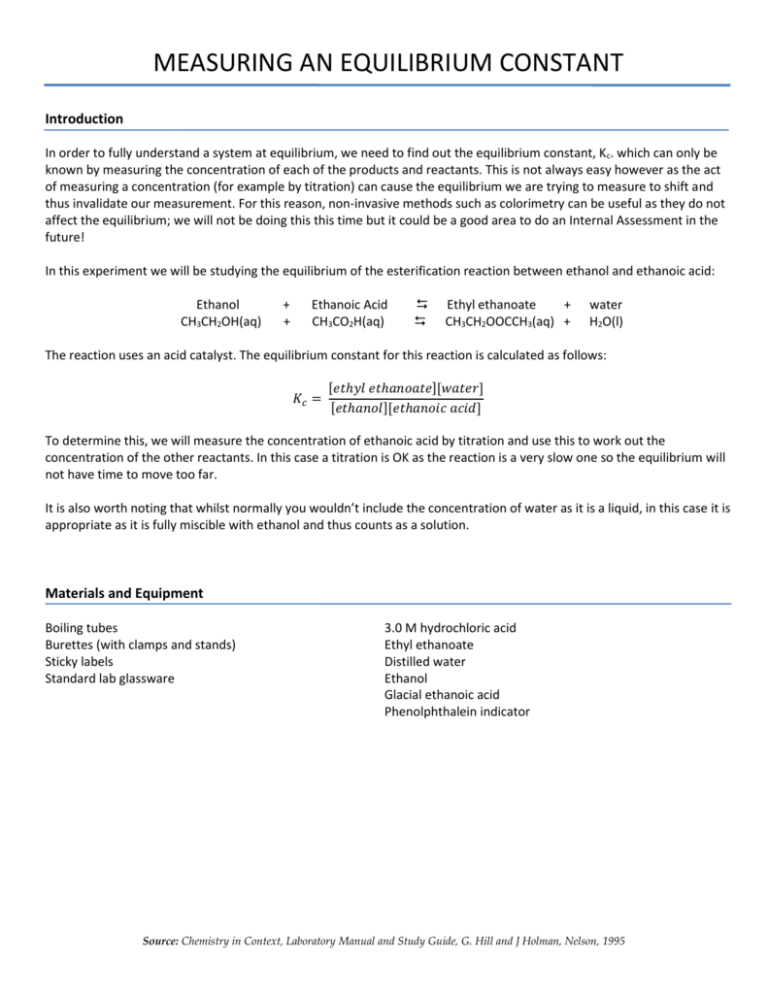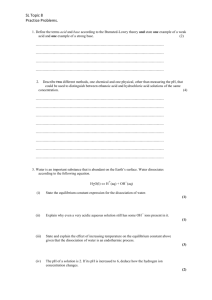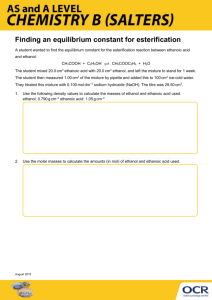Measuring an Equilibrium Constant
advertisement

MEASURING AN EQUILIBRIUM CONSTANT Introduction In order to fully understand a system at equilibrium, we need to find out the equilibrium constant, Kc. which can only be known by measuring the concentration of each of the products and reactants. This is not always easy however as the act of measuring a concentration (for example by titration) can cause the equilibrium we are trying to measure to shift and thus invalidate our measurement. For this reason, non-invasive methods such as colorimetry can be useful as they do not affect the equilibrium; we will not be doing this this time but it could be a good area to do an Internal Assessment in the future! In this experiment we will be studying the equilibrium of the esterification reaction between ethanol and ethanoic acid: Ethanol CH3CH2OH(aq) + + Ethanoic Acid CH3CO2H(aq) Ethyl ethanoate + CH3CH2OOCCH3(aq) + water H2O(l) The reaction uses an acid catalyst. The equilibrium constant for this reaction is calculated as follows: 𝐾𝑐 = [𝑒𝑡ℎ𝑦𝑙 𝑒𝑡ℎ𝑎𝑛𝑜𝑎𝑡𝑒][𝑤𝑎𝑡𝑒𝑟] [𝑒𝑡ℎ𝑎𝑛𝑜𝑙][𝑒𝑡ℎ𝑎𝑛𝑜𝑖𝑐 𝑎𝑐𝑖𝑑] To determine this, we will measure the concentration of ethanoic acid by titration and use this to work out the concentration of the other reactants. In this case a titration is OK as the reaction is a very slow one so the equilibrium will not have time to move too far. It is also worth noting that whilst normally you wouldn’t include the concentration of water as it is a liquid, in this case it is appropriate as it is fully miscible with ethanol and thus counts as a solution. Materials and Equipment Boiling tubes Burettes (with clamps and stands) Sticky labels Standard lab glassware 3.0 M hydrochloric acid Ethyl ethanoate Distilled water Ethanol Glacial ethanoic acid Phenolphthalein indicator Source: Chemistry in Context, Laboratory Manual and Study Guide, G. Hill and J Holman, Nelson, 1995 Preparing the Equilibrium Mixtures This will need to be done about a week before the measurements are taken to allow time to reach equilibrium. 1. As a class, work to prepare three boiling tubes of each of the following reaction mixtures. All liquids should be measured out from burettes as accurately as possible. Volumes of liquids/solutions used (cm3) Experiment 3.0 mol dm-3 Glacial Ethyl No. Hydrochloric Water ethanoic Ethanol ethanoate acid acid 1 5.0 0.00 5.0 0.0 0.0 2 5.0 1.0 4.0 0.0 0.0 3 5.0 2.0 3.0 0.0 0.0 4 5.0 3.0 2.0 0.0 0.0 5 5.0 0.0 4.0 0.0 1.0 6 5.0 0.0 4.0 1.0 0.0 7 5.0 0.0 0.0 1.0 4.0 8 5.0 0.0 0.0 2.0 3.0 2. For each tube you make you should immediately stopper it, label it with the experiment number and your name and leave in the test-tube rack at the back of the class. Titrating the Equilibrium Mixtures – one week later 1. Pour the contents of one of the test-tubes into a 100 cm3 conical flask and add a large splash of phenolphthalein.* 2. Titrate the contents with 1.0 mol dm-3 NaOH solution and stop at the point that the pink colour just remains. Do this very carefully as other groups are relying on your results. You should observe the colour change within a single drop. 3. Copy your data onto the shared table on the board. 4. Repeat steps 1-3 until no tubes remain. 5. Ensure that you have a copy of everyone’s results. Analysis 1. You will need to use a spreadsheet program to do this. Start by copying in the table above and the results for each of the three titrations for each run. 2. Calculate the mass of water present in the 5 cm3 of 3.0 M HCl. Do this by first calculating the mass of the HCl solution (density = 1.03 g/cm3). Subtract the mass of HCl present in 5 cm3 of 3.0 M solution – this remainder is the water. 3. Calculate the concentration of each of your compounds present at the start: a. Research the density of each liquid and use this to calculate the mass of each volume used. Don’t forget to include the water from the HCl along with the pure water used! b. Use the mass of each liquid to find the number of moles used and calculate concentration (use total volume) 4. Calculate the equilibrium concentration of ethanoic acid: a. From the average titration, calculate the total number of moles of acid present in your sample. b. Calculate the number of moles of ethanoic acid present by subtracting the number of moles of hydrochloric acid from the total moles of acid. c. Use the answer to 3b to calculate the concentration of ethanoic acid at equilibrium 5. Calculate the concentration of the remaining compounds by looking at how much the concentration of the ethanoic acid changed from start to finish and using logic to work out how the concentration of the others must have changed. Hint: use the reaction equation. 6. Calculate Kc for each run of the experiment. 7. How do your various values for Kc compare? Account for any similarities and differences. Source: Chemistry in Context, Laboratory Manual and Study Guide, G. Hill and J Holman, Nelson, 1995









